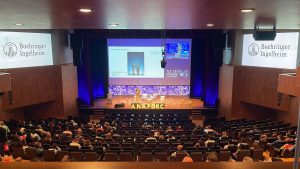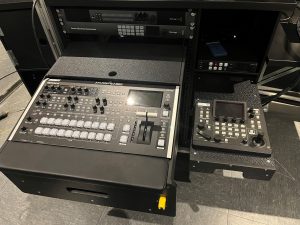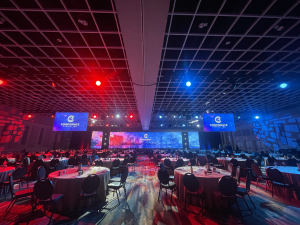- Roland has produced Pro A/V products for business and commercial use for decades.
- Products like the V-4 and the VR-5 cemented the company's A/V industry presence.
- Roland engineers continue to push the boundaries with A/V products, creating feature-packed units for cutting-edge uses.
While many instrument makers have acoustic origins, Roland has created electronic instruments—including synthesizers and drum machines—for over fifty years. Roland also produces Pro A/V products for business and commercial use, building a niche in music events and livestreaming. From Hamamatsu Research Institute, Takamitsu Shimizu, Yoshihide Kasai, and Yoshinobu Tatsui discuss Roland Pro A/V history, the first initiative to convert HDR to SDR on a switcher, and more.
Audio Visual Origins
Roland began as an electronic musical instrument manufacturer. How did the company start creating video equipment?
Takamitsu Shimizu: At first, we used to make audio products like mixers for DJs. Then, VJing began to get more and more exciting around 2000. In 1994, we created our first video-related product, an editing system called “Video-kun Editing Studio.” I thought we could pull something out of the product for VJs. This triggered the idea for video equipment.
That makes sense. Music came first and flowed into images. The first hit Roland video product was the V-4 in 2002. What target did you aim for specifically?
Shimizu: We knew VJing was popular, but we didn’t know how things worked in that world. So, we started by trying to put out a product. At that time, we only released musical instruments. So even if we suddenly made a video product, there was no sales destination. Therefore, we needed a place that was easy to sell a product intended for VJs.
From there, we gradually learned who was buying them by studying post-purchase data. About 40% of people who bought it were video directors like VJs. However, at that time, we noticed the other 60% of people who bought it were using it as a professional tool.
Yoshihide Kasai: At the time, I thought, “I’m using it like this.” When I was interviewing, I used a moving recording rack with the V-4. I remember using the chroma key in the background to make a temporary screen and showing it to the director. At that time, there wasn’t a switcher for $1,000, so there was no competition. We made it for VJs. Yet, it was affordable and compact, so it got used increasingly for business.
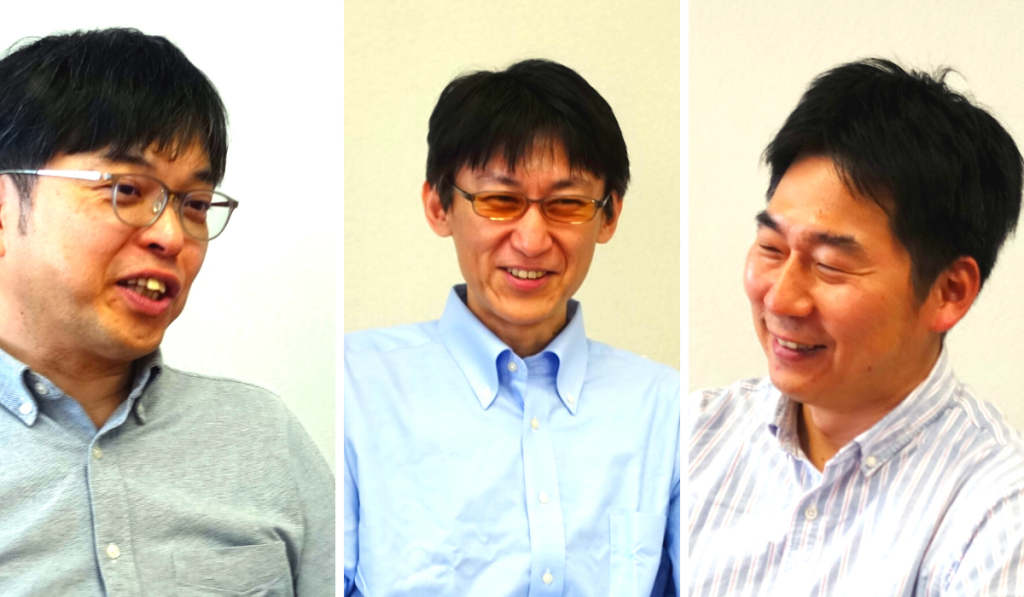
New Directions
From that point, Roland video products continued to move in that direction, bringing us to the present.
Shimizu: In response, we converted to a switcher for businesses called the LVS-400. The core was V-4, but we added a BNC connector. It was a simple switcher that switched with AB. Still, it was the beginning of our current business route. We changed the target and put it out.
Video is a field where it’s challenging to see who uses what products and where, especially as a new entrant. Was it difficult to conduct market research?
Shimizu: Yes. Therefore, we approached the areas where we were most familiar, such as music events. I looked for opportunities to ask how they could use our products. Later, this led to a PR series with video presenters.
Kasai: At that time, there was a trend where PA shops in town wanted to increase their video work. Roland knew this, and we had a place in that space. That’s continued since we came out with the V-4.
Roland A/V products are in many churches in North America.
Shimizu: It’s not so much that we found the worship market. Some US staff have involvement with their local churches. They knew each other or volunteered to deliver the mass. Initially, a dealer provided audio equipment for the video distribution network. So there was a sales channel within the worship community.
Yoshinobu Tatsui: As you can see from that example, any live event is a potential use case. The operator is a volunteer, so they’re not a professional. That’s why we don’t assume only professional use.
We made the V-4 for VJs. Yet, it was affordable and compact, so it got used increasingly for business.
Yoshihide Kasai
Birth of the VR-5
The VR-5, released in January 2011, helped the world learn about Roland switchers. How did it come about?
Shimizu: This also came from North America. The worship market is quite large, so there was demand. The beginning of the project is that when video and audio are together, the most compressed version is the one most likely to get used. At first, I wasn’t aware of streaming at all, so we didn’t even have USB streaming out. As a result, I was fortunate that the streaming market got excited. We did various things in the testing to see what it would be like if we included the function.
When the Great East Japan Earthquake occurred in March 2011, I wanted more information that the mass media didn’t report. I gained a tremendous sense of citizenship from this. The VR-5 came out in January, just before that. This is an example of a time I was ahead of something without trying too hard. There was a trend born of students learning journalism through live video. At that time, university laboratories actively introduced the product.
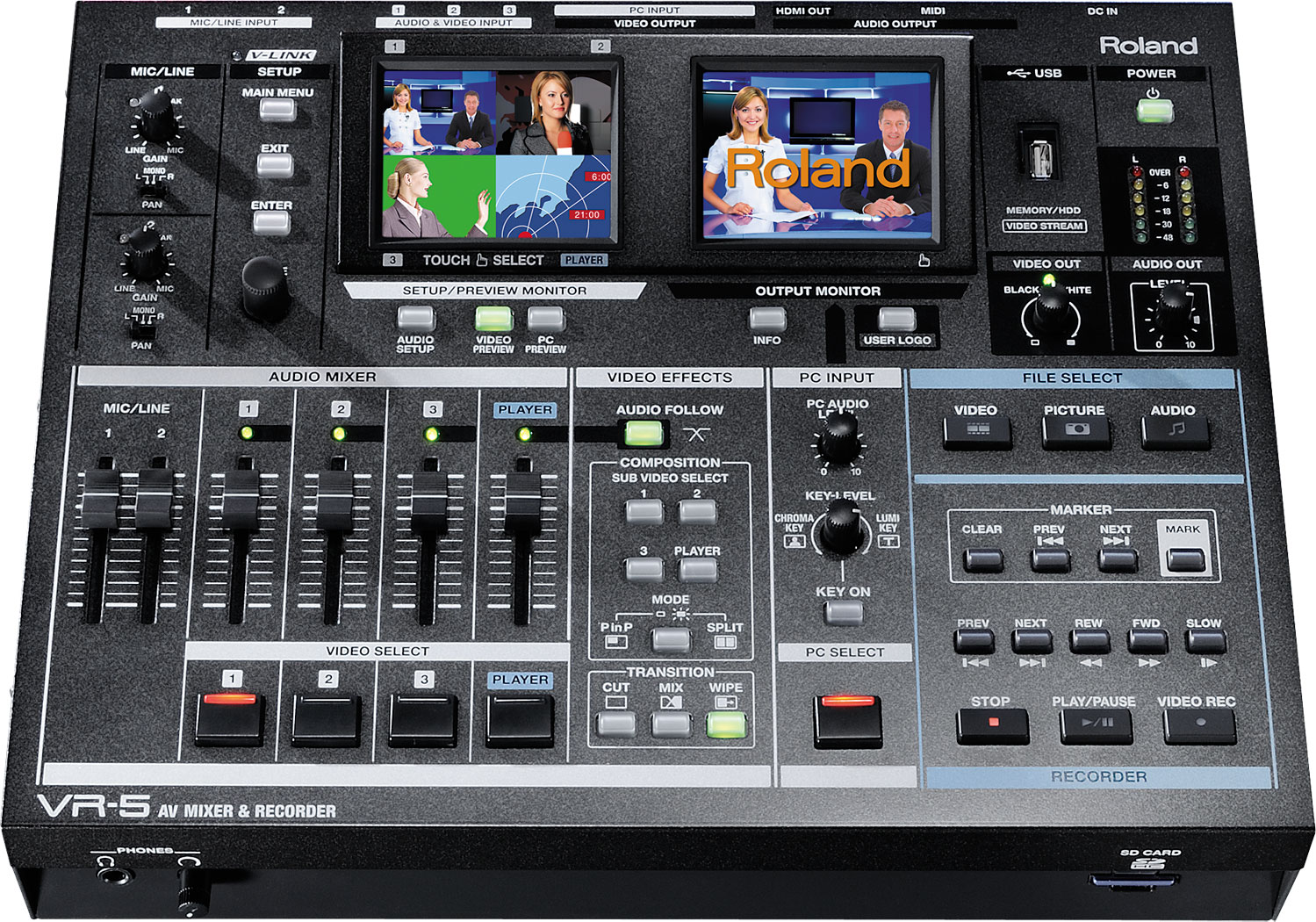
The VR-5 was an example of a time I was ahead of something without trying too hard. There was a trend born of students learning journalism through live video. At that time, university laboratories actively introduced the product.
Takamitsu Shimizu
Integration
The integrated video switcher and audio mixer are features of the VR series. When did you come up with that concept?
Tatsui: Our founder’s father loved organs. The organ is all played by one person, right? In that kind of flow, the idea is a video will come out like when you play the keyboard. From there, it leads to another idea—like a video synthesizer.
In addition to switchers, we started to consider these things like the PR series video presenter and the CG-8 visual synthesizer. There was a sound, and there was an image to produce it.
Kasai: There was a culture where you wanted to pack everything in one. I also tried mixing synths with two sound sources.
Shimizu: At that time, our founder had a diode theory. Diodes only go in one direction, correct? Video people can also do audio. Audio people wanted to try video, and the learning threshold was quite high. It’s like diodes. Most video products are not made with audio in consideration. He often said that putting audio elements in it would lead to other users and expand the market.
Professional Acceptance
The VC-300HD video converter, released in 2007, was the start of multi-format products that followed. Why did Roland begin making converters?
Shimizu: At first, the project’s purpose was the interface box. The PR series was a straightforward product for us to imagine customers enjoying, and we placed high importance on it. I thought we could do an IO breakout box that somehow converted a PR-1000HD that could only output DVI into a component or SDI. Then the converter sold better than the presenter, and I found a different killer solution.
Kasai: There were models with and without SDI, but in the end, only models with SDI sold. I realized that SDI was so important. Until then, I’d never set foot in a broadcasting station. Once I was able to do this with a broadcaster, I started going there to introduce our new products in a personal way.
Before Roland, it was costly to find a multi-converter. $10,000 USD was cheap. There was tremendous demand at the Beijing Olympics in 2008 because I wanted a 50Hz/60Hz converter to support high definition. Having to bring it to Beijing and do various things, the converter with the processing amplifier was very useful. The product fit the times.
Multi-format Development
From there, the VR and V series included many products that supported multi-format. Ahead of trends, the V-600UHD in 2019 was at the forefront of 4KHDR support. Tell us about this.
Shimizu: My way of thinking has stayed the same on this topic. I think it’s the destiny of a major manufacturer to be on the cutting edge, and we’ve been expanding with multi-formatting since the analog era. It was time to expand it to 4K. It’s still an image with 4K or HDR in the multi-format, so it’s not that we changed our approach and entered the cutting edge.
Kasai: With most of the TVs for home use in 4K, we are finally releasing 4K-compatible products as video production equipment. It’s still slower than ever. However, I believe the latest products include cutting-edge or leading functions.
Since the VC-300HD, Roland has been recognized as multi-format. Then, when the norm became 4K, we needed to respond to the idea that it is not the only resolution.
Yoshihide Kasai

4K Gold
There are very few 4K products of this size which is one of its highlights. How did you differentiate yourself?
Kasai: Since the VC-300HD, Roland has been recognized as multi-format. Then, when the norm became 4K, we needed to respond to the idea that it is not the only resolution. Of course, PC output, camera output, and SDI-based video output were multi-formats, but only if they could get handled together. The PC gets processed at 4K/4:4:4, and we cannot remove that. And SDI has 12G SDI which is also not removable.
Shimizu: We thought so because we sold the V-800HD for a long time, and people used it in many situations. Even if you go to 4K, the size is probably about this size, and the input channel is this much, and the cost for middle-class events is this much. It’s here that there is scalability, so I feel like we’ve arrived.
4K gets used in the staging field, and of course, it is a multi-format, so PCs can enter at any resolution and upconvert HD materials. There is even analog RGB. What kinds of situations can you see needing this use?
Tatsui: It depends on the time of day. The idea that we can support analog is quite persistent. There are many cases where clients have to connect their personal computers. So there is a need to support things like analog RGB only or broken HDMI terminals.
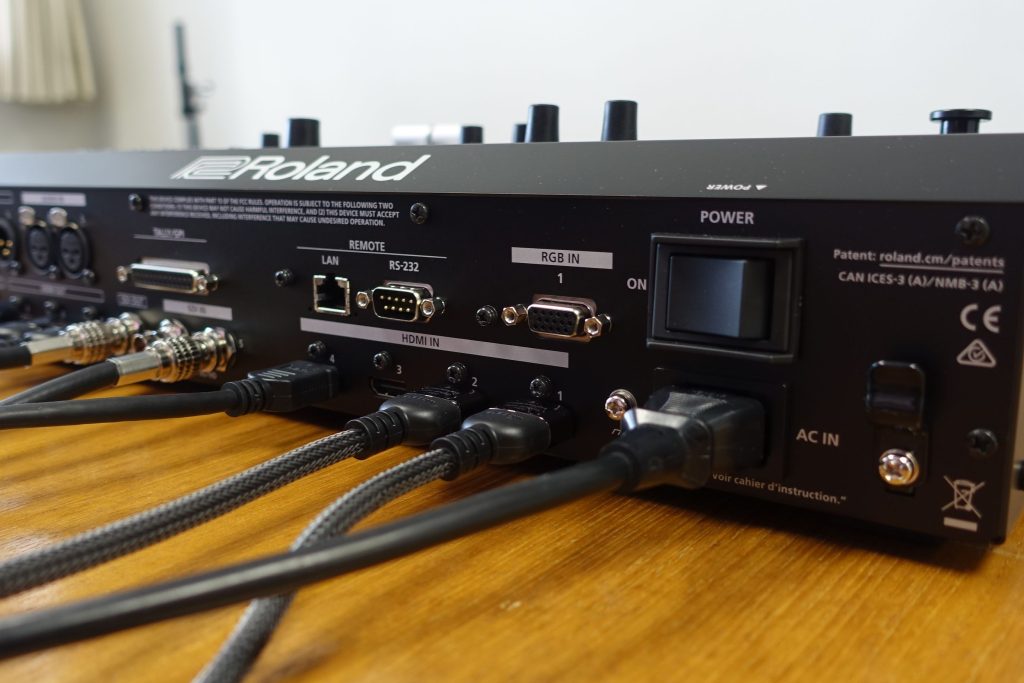
In those cases, the switcher acts as a cushioning device that accepts everything, not a site where the format is a unified system. There is HLG as HDR, PQ, and some use Log. What formats do you support?
Tatsui: Both HLG and PQ. You can mix inputs, and the output can get selected as one system format. However, the PQ is only HDR 10. Log output is tough at the moment. However, since the input has a gamma curve correction function, it is widely accepted. I think it’s tough to convert your own Log properly.
Kasai: There is a dedicated converter there, so I would like people to use it.
HDR to SDR
The V-600UHD focused on HDR to SDR conversion. Why would a user convert HDR input to SDR in the first place?
Tatsui: LED displays and projectors usually have 4K and 8K resolutions, but the main product is still SDR and doesn’t support HDR.
Kasai: Normally, when it comes to 4KHDR support, I think there is an idea that the input and output must get aligned as a whole system, but I don’t think so. The main thing is that even if you use only the camera with 4KHDR, there are sufficient merits.
Why should someone turn their camera into an HDR device?
Tatsui: One reason is when you take a picture with an SDR camera, there are scenes where it will inevitably need white or black. If you take it with an HDR camera, you can shoot with sufficient quality. Even if you convert it to SDR, you can put it out to SDR while maintaining its quality. That’s where it’s big.
Kasai: Even within the same SDR range, you can use it within the range you want to use a lot.
The idea of changing with a single parameter is an approach I've done for a while in the musical instrument world. We wondered how we could make it like an instrument.
Yoshinobu Tatsui
The Power of a Single Knob
Such adjustments would involve a fair number of parameters, but in live performances, you have to do it in real time. Is it a good thing to be able to use just one knob?
Tatsui: We went through a lot of trial and error to create various curves. Some things didn’t work with simple calculations alone.
Kasai: From the beginning, the concept was to make something end up as HDR and SDR with a single knob. HDR to SDR can’t get entered without crushing somewhere. I’ll look for the most effective part with the human eye and make a curve. I want to increase the number of parameters more and more, but I was quite careful about not increasing too much.
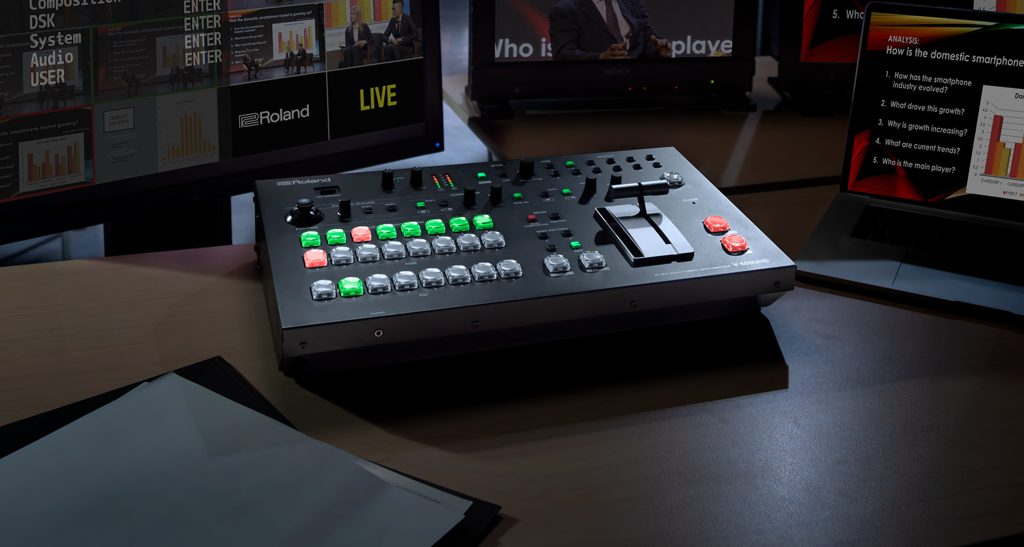
What parameter adjustments does the one knob control? Is it connecting and changing multiple gamma curves?
Kasai: The adjustment is to bring the width of what you want to see into SDR. We hold it up or lift the bottom and put it within the scope of SDR.
Tatsui: The idea of changing to a setting that feels good with a single parameter is an approach I’ve done for a while in the musical instrument world. Like an analog compressor, there are various parameters. If you turn it this much, there are about three settings that are OK. We wondered how we could make it like an instrument.
Designing the Foundation
Is that the most challenging aspect of this product?
Shimizu: I spent a lot of time planning it beginning over a year ago. Before that, there were various other versions of products, but not in this form. When we first worked with 4K, we never used a device at all because of the idea of designing the foundation. Think of a rack-mounted successor to the VC-300HD. I considered that concept for quite a long time.
In terms of marketing, where would this product be popular?
Shimizu: HDR content is coming. 4K is on its way. For events of a certain size, there’s no HDR system like this in the world. Currently, the V-600UHD is the only product available, so there are many inquiries.
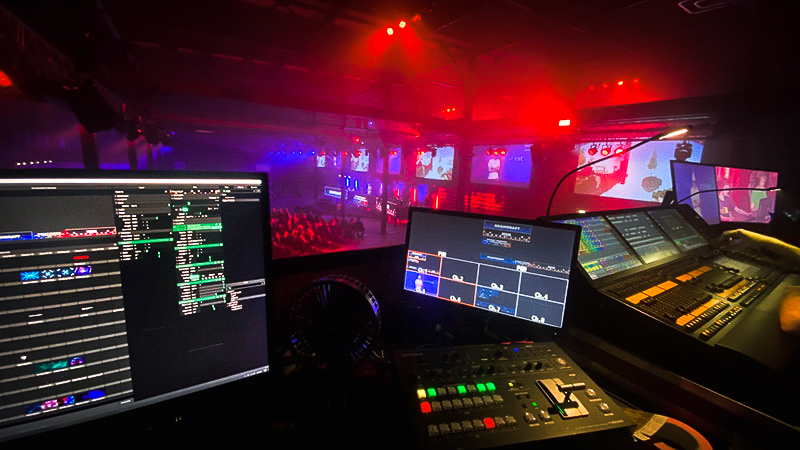
Our products are always made to solve problems in the field. Roland’s approach to creating such content is unique to the company, and it’s the starting point for many users who trust us.
Takamitsu Shimizu
Faster than Ever
In the events industry, the technology cycle is faster than ever. LED displays are widespread, with brightness getting higher and higher. They have advanced rapidly in recent years.
Shimizu: The biggest market for LED is China, but LED is all over the place. Competition is fierce, cost reductions are fierce, and cheap LED displays get exported worldwide. Even small shopping malls install 200-inch LED displays. In this environment, 4K is also steadily reducing costs. 4K isn’t always the perfect solution. However, interest is a little larger than HD and is steadily increasing.
From its early products to 4K/HDR, Roland video equipment is constantly evolving. Our products are always made to solve problems in the field. Roland’s approach to creating such content is unique to the company, and it’s the starting point for many users who trust us. Even when something is not cutting-edge, it’s born from the attitude that we can always ride the tides of the times.


